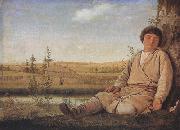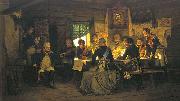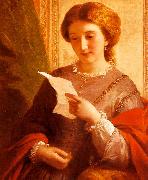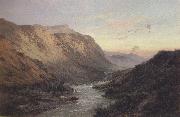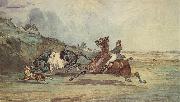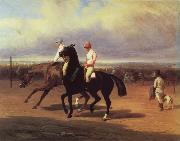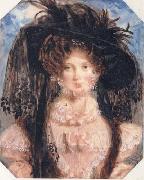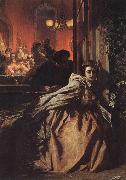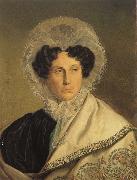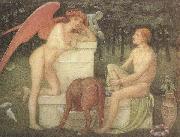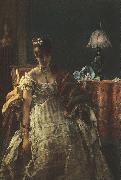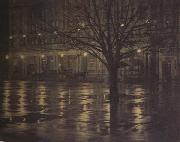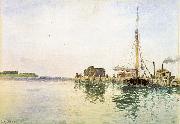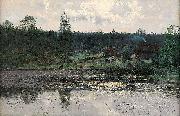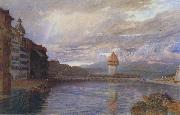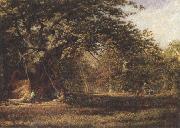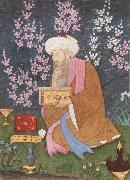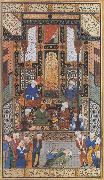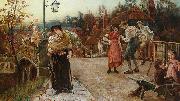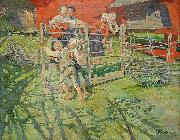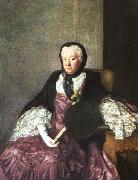|
|
|
|
 |
Alexej Kondratjewitsch Sawrassow
|
|
Alexei Kondratyevich Savrasov (Russian) (May 24, 1830 - October 8, 1897) was a Russian landscape painter and creator of the lyrical landscape style.
Savrasov was born into the family of a merchant. He began to draw early and in 1838 he enrolled as a student of professor Rabus at the Moscow School of Painting, Sculpture and Architecture (graduated in 1850), and immediately began to specialize in landscape painting.
In 1852, he traveled to Ukraine. Then, in 1854 by the invitation of the Grand Duchess Maria Nikolayevna, President of the Imperial Academy of Arts, he moved to the neighborhood of St. Petersburg. In 1857, Savrasov became a teacher at the Moscow School of painting, sculpturing and architecture. His best disciples, Isaac Levitan and Konstantin Korovin, remembered their teacher with admiration and gratitude.
|
|
 |
alexej von jawlenskij
|
|
Alexej Georgewitsch von Jawlensky (13 March 1864 ?C 15 March 1941) was a Russian expressionist painter active in Germany. He was a key member of the New Munich Artist's Association (Neue Kunstlervereinigung Menchen), Der Blaue Reiter (The Blue Rider) group and later the Die Blaue Vier (The Blue Four).
Alexej von Jawlensky was born in Torzhok, a town in Tver Governorate, Russia, as the fifth child of Georgi von Jawlensky and his wife Alexandra (n??e Medwedewa). At the age of ten he moved with his family to Moscow. After a few years of military training, he became interested in painting, visiting the Moscow World Exposition circa 1880.
In 1896 he moved to Munich, where he studied in the private school of Anton Ažbe. In Munich he met Wassily Kandinsky and various other Russian artists, and he contributed to the formation of the Neue K??nstlervereinigung M??nchen. His work in this period was lush and richly coloured, but later moved towards abstraction and a simplified, formulaic style.
Alexej von Jawlensky. Abstract Head, c. 1928Von Jawlensky died in Wiesbaden, Germany on 15 March 1941. He and his wife Helene are buried in the cemetery of St. Elizabeth's Church, Wiesbaden. |
|
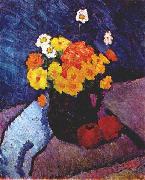 |
Alexej von Jawlensky
|
|
Alexej Georgewitsch von Jawlensky (13 March 1864 - 15 March 1941) was a Russian expressionist painter active in Germany. He was a key member of the New Munich Artist's Association (Neue Kenstlervereinigung Menchen), Der Blaue Reiter (The Blue Rider) group and later the Die Blaue Vier (The Blue Four).
|
|
 |
Alexey Bogolyubov
|
|
16 March 1824 - 3 February 1896) was a Russian landscape painter.
Bogolyubov was born in the Pomeranian village of Novgorod Gubernia. His father was retired colonel Pyotr Gavriilovich Bogolyubov. Bogolyubov's maternal grandfather was the well-known philosopher and social critic Alexander Radishchev.
In 1841, Alexey graduated from military school, serving in the Russian Navy and travelling with the fleet to many countries. In 1849, he started to attend classes of the Saint Petersburg Academy of Arts, where he studied under Maxim Vorobiev. The young painter was greatly influenced by Ivan Ayvazovsky. In 1853, he finished the Academy with a major Gold medal. He retired as a navy officer and was appointed an artist to the Navy headquarters.
From 1854 to 1860, he travelled around Europe and worked prolifically. In Rome, he was acquainted with Alexander Ivanov, who convinced Bogolyubov to focus more on drawing. In Desseldorf, Bogolyubov took classes from the painter Andreas Achenbach. In Paris, he admired the artists of the Barbizon School. French painters Camille Corot and Charles François Daubigny were good friends and collaborators with Bogolyubov.
Bogolyubov returned to Russia in 1860. He exhibited his works in the Academy and received the title of professor. For some time, he taught in the Academy. In the 1860s, he traveled along the Volga. His paintings lost all traces of Romanticism, replacing that element with staunch realism of the natural. In 1871 he was elected to the Imperial Academy of Arts.
Sailing ships, 1860From 1870, he became close to the The Wanderers art movement, participated in all their exhibitions. He became a member of their board. Much older than most of the other members of the movement, he had reservations on their social ideas. In 1873, Bogolyubov left the ? in solidarity with his fellow Itinerants. He even tried to create an alternative Russian Academy of Arts in Rome.
|
|
|
|
|
|
 |
Alexey Tyranov
|
|
(Russian,1801 - 3 August 1859) was a Russian painter. Early in his career he painted icons with his brother; he then traveled to St. Petersburg to study at the Academy, where he took lessons with Alexey Venetsianov. From 1836 he was a pupil of Karl Bryullov. Tyranov chiefly painted portraits and genre scenes; he exhibited at a number of venues in the city throughout the 1830s and 40s. |
|
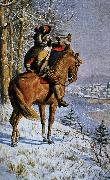 |
alexis de tocqueville
|
|
was born in Paris on July 29, 1805, of an aristocratic Norman family. He studied law in Paris (1823-1826) and then was appointed an assistant magistrate at Versailles (1827).
|
|
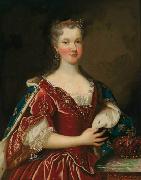 |
Alexis Simon Belle
|
|
(12 January 1674 - 21 November 1734) was a French portrait painter, known for his portraits of the French and Jacobite nobility.
Belle was born in Paris, the second child and only son of Jean-Baptiste Belle (born before 1642, died 1703), also a painter, and of Anne his wife (died 1705).
Belle's birth and baptism are recorded in the parish register of the church of Saint-Sulpice, Paris, and quoted in Eugene Piot's Le Cabinet de l'amateur for the years 1861 and 1862
|
|
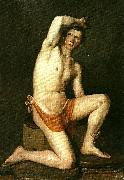 |
alexis wetterbergh
|
|
wetterberghs malning bar professor sandbergs godkannande paskrift, men eftersom maleri inte forekom pa konstakademiens schema fore 1856 |
|
|
|
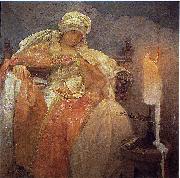 |
Alfons Mucha
|
|
known in English as Alphonse Mucha, was a Czech Art Nouveau painter and decorative artist, known best for his distinct style. He produced many paintings, illustrations, advertisements, postcards, and designs.
Alphonse Maria Mucha was born in the town of Ivančice, Moravia (the present Czech Republic). Although his singing abilities allowed him to continue his education through high school in the Moravian capital of Brno, drawing had been his main hobby since childhood. He worked at decorative painting jobs in Moravia, mostly painting theatrical scenery. During 1879, he relocated to Vienna to work for a major Viennese theatrical design company, while informally augmenting his artistic education. When a fire destroyed his employer's business during 1881 he returned to Moravia, to do freelance decorative and portrait painting. Count Karl Khuen of Mikulov hired Mucha to decorate Hrušovany Emmahof Castle with murals, and was impressed enough that he agreed to sponsor Mucha's formal training at the Munich Academy of Fine Arts.
|
|
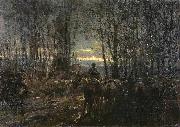 |
Alfred Bastien
|
|
(16 September 1873e7 June 1955) was a Belgian artist, academic and soldier.
He attended the Academie Royale des Beaux-Arts in Ghent, where he studied with Jean Delvin. He then enrolled in the Academie Royale des Beaux-Arts in Brussels, where he studied with Jean-François Portaels. He won the Prix Godecharle there in 1897. He traveled to Paris, where he enrolled in the Ecole des Beaux-Arts in Paris. He was in Paris when hostilities broke out in what would become the First World War.
|
|
|
|
|
|
|
|
|
|
|
|
|
|
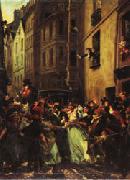 |
Alfred Dehodencq
|
|
French Painter.
Paris 1822 - Paris 1882.
Specializes in Orientalism. |
|
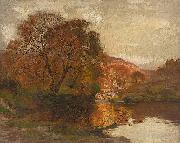 |
Alfred East
|
|
(December 15, 1849 C September 28, 1913) was an English painter.
He was born in Kettering in Northamptonshire and studied at the Glasgow School of Art. His romantic landscapes show the influence of the Barbizon school. His The Art of Landscape Painting in Oil Colour was published in 1906. In April 1888 he had shared an exhibition at the galleries of the Fine Art Society with T.C. Gotch and W. Ayerst Ingram, and was commissioned the following year by Marcus Huish, Managing Director of the Society, to spend six months in Japan to paint the landscape and the people of the country. When the exhibition of 104 paintings from this tour was held at the Fine Art Society in 1890 it was a spectacuar success. He was awarded a Knighthood in 1910 by King Edward VII. His portrait was painted by Philip de Laszlo. On Sunday, 28 September 1913, Alfred East died at his London residence in Belsize Park. |
|
|
|
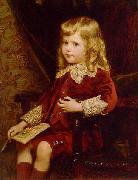 |
Alfred Edward Emslie
|
|
Alfred Edward Emslie (1848 London -1918) was an English genre and portrait painter, and photographer, living at The Studio, 34, Finchley Road, N. W.
He was the son of the engraver, John Emslie, and brother of John Phillipps Emslie, the figure painter. Married to miniature painter Rosalie M. Emslie, they had a daughter, Rosalie Emslie, who became a figure, portrait and landscape painter. Emslie turned increasingly to portraiture later in life. He had a great passion for the Orient, and spent three months exploring Japan. He was a elected an associate of the Royal Society of Painters in Water Colours in 1888 and a member of the Royal Society of Portrait Painters in 1892.
|
|
|
|
|
|
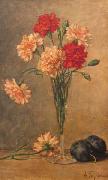 |
Alfred Hirv
|
|
(born March 26, 1880 in Pechory - died May 26, 1918 in Pskov) was an Estonian painter, known especially for his still lifes. For a time he studied with Julius von Klever in Saint Petersburg; further studies took him to Rome and Munich, where he studied at the school of Anton Ažbe. His paintings are reminiscent of the style of the Dutch Golden Age. Works by Hirv can be found in the Estonian Art Museum.
|
|
|
|
|
|
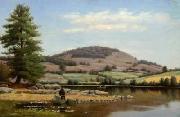 |
Alfred Ordway
|
|
(1821 - 1897) was an American landscape and portrait painter, and one of the founding fathers of the Boston Art Club.
Alfred was born in Roxbury, Massachusetts to mother Currier, and father Thomas Ordway on March 9, 1821. With his father being the cities' clerk, Alfred spent the majority of his childhood in Lowell, Massachusetts. His family can be traced back to the early 17th century when James Ordway settled in Dover, New Hampshire. Both his parents fought in the Revolutionary War, and his grandfather, Nehemiah Ordway, a physician in Amesbury, Massachusetts, was put in charge "to form and equip a company for Bunker Hill". |
|
|
|
|
|
|
|
 |
Alfred Seifert
|
|
(September 6, 1850 Praskolesy, Bohemia - February 6, 1901, Munich, Germany) was a Czech-German painter, famous for his female portraits.
He was born in Praskolesy (present-day Czech Republic) but within a few months, his family moved to nearby Hořovice.
As a child, he fell seriously ill, could not walk for four years and spent two years in an orthopedic institution. Instead of playing, he started to draw pictures and his artistic talent soon started to emerge. His first teachers were Karel Werbs, inspector of Estates Gallery at Prague Castle, and Alois Kirnig, landscape painter. |
|
|
|
|
|
|
|
|
|
|
|
|
|
|
|
|
|
|
|
|
|
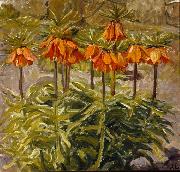 |
Alhed Larsen
|
|
Alhed Maria Larsen nee Warberg (7 April 1872, Heden near Faaborg - 31 August 1927, Odense), the wife of Johannes Larsen, was one of the Fynboerne or "Funen Artists" who lived and worked on the Danish island of Funen.
Alhed Larsen was the daughter of Albrecht Christoffer Warberg, who managed the Erikshåb estate in the south of Funen. The estate became an early meeting place for the artists who later became known as the Fynboerne. As early as 1885, Larsen began to have painting lessons with Fritz Syberg and she became a friend of Johannes Larsen, whom she married in 1898, and of Peter Hansen. Anna Syberg, Hansen's sister, Marie Schou and Christine Swane, Johannes Larsen's sister, became lifelong companions. Ahled Larsen appears to have been a central figure for the Funen Painters, frequently acting as hostess.
Alhed Larsen had also had drawing lessons from her uncle Ludvig Brandstrup with whom she stayed in Copenhagen where she worked as a porcelain decorator at the Royal Copenhagen factory from 1890 to 1893.
When she finally married Johannes Larsen in 1898, the couple moved to Kerteminde in north-east Funen where they soon built their new home, Mollebakken, on the outskirts of the town. The house was extended on several occasions, becoming one of the most beautiful artists' homes in the country. With its 16 bedrooms, it served as a central meeting place for the Funen Painters and their friends, in the caring hands of Alhed Larsen. |
|
|
|
|
|
|
|
|
|
|
|
|







